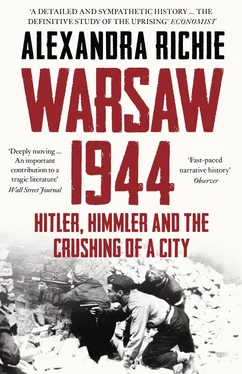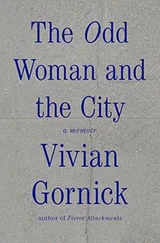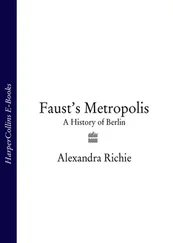The notion that the Germans were about to collapse was widespread in Warsaw in the final days of July 1944. For weeks Warsawians had watched as bedraggled German soldiers made their way through the city, wounded, filthy and dejected. When news of the plot to kill Hitler reached Warsaw it really did seem as if the Third Reich was about to implode. The AK believed that the time was right to rise up against the departing Germans and seize the capital just before the Soviets arrived. They could welcome the Red Army into their city as the rightful ‘hosts’, and score an enormous political victory over Stalin. That, at least, was the plan.
The second important event of that summer in relation to the uprising was the 20 July attempt to assassinate Hitler at the Wolfsschanze, because it elevated Himmler at the expense of the Wehrmacht, with terrible consequences for Warsaw. The Führer survived the attack, only to become increasingly paranoid and suspicious of his generals. Himmler took advantage of their fall from grace, and worked to increase his own power. After the beginning of the Warsaw Uprising Guderian requested that Warsaw be put under the jurisdiction of the 9th Army, but Himmler wanted the prize for himself. Hitler deferred to the Reichsführer SS. As Guderian put it, ‘Himmler had won’. The uprising would be put down not by regular troops, but by some of the most notorious of Himmler’s SS thugs, who had honed their skills in the killing fields of Byelorussia – Erich von dem Bach-Zelewski, Oskar Dirlewanger, Bronisław Kaminski and members of Einsatzgruppe B, who had been unceremoniously ejected from their comfortable fiefdoms in the east. As a result of this decision, the crushing of the Warsaw Uprising would become the only major German ground combat operation of the Second World War to be run almost entirely by the SS. 3
The third decisive event was Field Marshal Walter Model’s counter-offensive, which began only hours before the start of the uprising. It was the only major offensive launched by the Germans against the Soviets in the summer of 1944, and it too would have far-reaching consequences.
On 31 July the people in the countryside around the pretty town of Radzymin, thirty-five kilometres east of Warsaw, felt the earth shaking underfoot as if in an earthquake. Smoke and dust filled the air as countless tanks rumbled across the sandy fields and into position. The battle against the Soviets was about to begin.
Model and Guderian had amassed some of their best troops for the attack: the Waffen SS Viking Panzer and Totenkopf Divisions, the Luftwaffe’s Hermann Göring Division, General von Saucken’s 39th Panzer Korps and the 4th and 19th Panzer Divisions. It was a formidable force, and it slammed into the unsuspecting Red Army as it made its way towards Warsaw, changing the course of the war.
Like Bagration itself, these battles are now largely forgotten, but they were titanic clashes, with the loss of hundreds of tanks. The Battle of Wolomin was the largest tank battle fought on Polish soil in the entire war, and it saw the German Panzer divisions crush the Soviet 3rd Tank Corps and maul the 8th Guards Tank Corps. Fierce fighting raged for weeks throughout the area; indeed, the Soviets would succeed in finally pushing all of the German forces over the Vistula only in January 1945. One consequence was that even if Hitler had wanted to send regular troops in to retake Warsaw there were simply none available; all were needed at the front.
Tragically, the Poles waiting in Warsaw mistook the distant sounds of battle for the triumph of the Red Army. With no direct contact with the Soviets, they could only guess at what was happening, and they miscalculated badly. The AK’s Warsaw commander Colonel ‘Monter’ rushed into a meeting at 5 o’clock on 31 July with the incorrect information that the Soviets ‘are in Praga’, and urged that to delay the uprising would be a disaster. General Bór – who was in many ways unsuited for the role thrust upon him by history – did not wait for verification, but gave the order to commence the uprising. Neither Bór nor Monter had understood the significance of Model’s counter-offensive. There was now no way that the Red Army could have reached Warsaw in the first week of August, but the Poles did not know that. Mobilization for the uprising had already begun. It would commence at 5 p.m. on 1 August, and it would ultimately bring utter destruction to the city of Warsaw.
When ancient Carthage began to rebuild itself in the second century BC, after the Second Punic War, the Romans were worried. The city was seen as a threat to Roman domination of North Africa; and after some deliberation Rome’s senators decided that it had to be attacked, conquered, and erased from history.
They knew that the task would not be easy. Carthage was strongly fortified, and it contained a desperate population who were determined to fight rather than be crushed into submission by the Romans.
The attack began in 149 BC; Carthage fought back, and the Romans set up a siege. The Carthaginians defended their city like lions, fighting from house to house and street to street, but eventually the Romans proved too powerful, and Carthage capitulated in 146 BC. Fifty thousand of its inhabitants were sold into slavery, the city walls were torn down and the city razed to the ground. It is said that the Romans even sowed salt in the ruins so that nothing would grow there. Carthage had ceased to exist.
Hitler might well have modelled his treatment of Warsaw on that ancient city. In his play The Fall of Carthage the Nazi writer Eberhard Wolfgang Möller championed the great Roman republic – the bearer of all civilization – and applauded it for grinding ‘corrupt’ and ‘venal’ Carthage into the dust. The Berlin audiences clapped and cheered. For Hitler, the symbolism was clear.
If Carthage is the epitome of the wanton destruction of a great city in the ancient world, the sacking of Warsaw was its unique counterpart in modern history. No European capital has undergone such trauma at the hands of an invader. After the merciless bombing raids that began on 1 September 1939 its population was terrorized by the Gestapo, and almost its entire Jewish community was murdered. During the uprising of the summer of 1944 its people were massacred, besieged, pulverized and burned. In the end the entire population, which before the war had numbered over 1.3 million people, was gone. More than 400,000 of Warsaw’s Jews were dead. Over 150,000 of its remaining citizens died during the uprising and lay buried under the rubble; 18,000 members of the AK also lay dead. The remaining citizens might still have found shelter in the city, but Hitler would not permit anyone to remain; hapless civilians were hauled from their shelters and sent to Pruszków transit camp on the outskirts of the city, from where 60,000 innocent men, women and a substantial number of children were despatched to concentration camps including Auschwitz, Ravensbruck and Dachau, where many of them perished. Nearly 100,000 people were sent as forced labourers to the Reich, the last source of cheap labour for Albert Speer and Fritz Sauckel. 4Ernst Kaltenbrunner, chief of the RSHA, the Reich’s Security Office, warned of the security risk of so many young men being brought to German towns; as a result more children and women were used instead. Families were deliberately split up at Pruszków; many were never reunited.
The rest – those too old or too sick to be of any use to the Reich – were sent off to find somewhere to live in occupied Poland. This too was fraught with problems. The poor people in the countryside had no place for them, and many refugees were forced to eke out an existence by tending animals or cooking. One group, above all, remained in grave danger throughout.
For a brief moment in August 1944, when the city was ‘free’, Warsaw’s Jews had been rid of Nazi tyranny, but as the Germans retook district after district the terror returned with them. The Poles suffered terribly during the uprising, but the danger for the Jews was infinitely worse – even at the very end the Germans showed no mercy, and killed any they could find. SS specialists under Alfred Spilker scoured the crowds of refugees trudging to Pruszków for anyone who looked Jewish; they were taken aside and shot. Some, like Stanisław Aronson and Yehuda Nir, miraculously survived by mingling in the crowds; others, like Władysław Szpilman and other so-called ‘Robinsons’, took their chances by hiding in the stricken city until Soviet liberation in January 1945.
Читать дальше





![Traudl Junge - Hitler's Last Secretary - A Firsthand Account of Life with Hitler [aka Until the Final Hour]](/books/416681/traudl-junge-hitler-s-last-secretary-a-firsthand-thumb.webp)






